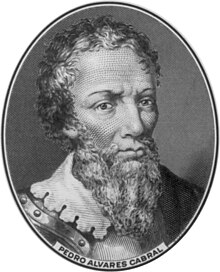Pedro Álvares Cabral: Difference between revisions
| Line 47: | Line 47: | ||
==References== |
==References== |
||
me im a reference |
|||
* {{Catholic}} |
* {{Catholic}} |
||
Revision as of 13:04, 23 October 2008
This article includes a list of references, related reading, or external links, but its sources remain unclear because it lacks inline citations. |

Pedro Álvares Cabral (about 1467/1468/1469 – about 1520; IPA: [ˈpeðɾʊ ˈaɫvɐɾɨʃ kɐˈβɾaɫ] in Portuguese, [ˈpedɾu ˈawvaɾiʃ caˈbɾaw] in Brazilian) was a Portuguese navigator and explorer. Cabral is generally regarded as the European discoverer of Brazil (22 April 1500).
Cabral is thought to have been born in Belmonte, in the Beira Baixa province of Portugal. He was the third son of Fernão Cabral (c. 1427-c. 1492), Governor of Beira and Belmonte, and Isabel de Gouveia de Queirós (c. 1433-c. 1483; descendant of the first King of Portugal, Afonso I), and married Isabel de Castro, the daughter of the distinguished Fernão de Noronha (also descendant of King Afonso I). He must have had excellent training in navigation and a large amount of experience as a seaman, for King Manuel I of Portugal considered him competent to continue the work of Vasco da Gama.
His commission was to establish permanent commercial relations and to introduce Christianity wherever he went, using force of arms if necessary. The nature of the undertaking led rich Florentine merchants to contribute to the equipment of the ships and also led priests to join the expedition. Among the captains of the fleet, which consisted of 13 ships with 1,500 men, were Bartolomeu Dias, Pêro Vaz de Caminha, Sancho de Tovar and Nicolau Coelho, the latter the companion of Vasco da Gama. Vasco da Gama himself gave the directions necessary for the course of the voyage.

The fleet of thirteen ships left Lisbon on 9 March 1500, and following the course laid down, sought to avoid the calms off the coast of Gulf of Guinea. On leaving the Cape Verde Islands, where Luís Pires was forced by a storm to return to Lisbon, they sailed in a decidedly southwesterly direction. On 22 April a mountain was visible, to which the name of Monte Pascoal was given; on 23 April Cabral landed on the coast of Brazil, and on 25 April the entire fleet sailed into the harbor called Porto Seguro. Cabral perceived that the new land lay east of the line of demarcation made by Pope Alexander VI (see Treaty of Tordesillas), and at once sent André Gonçalves (according to other authorities Gaspar de Lemos) to Portugal with the important tidings. Believing the newly-discovered land to be an island he gave it the name of Island of the True Cross (or Island of Vera Cruz) and took possession of it by erecting a cross and holding a religious service. The service was celebrated by the Franciscan, Father Henrique de Coimbra, afterwards Bishop of Ceuta. The iron cross used in that service is now in Cathedral Treasure in Braga. It was taken back to Brazil for the inauguration of Brasilia in 1960.

Cabral resumed his voyage on 3 May 1500. By the end of the month the fleet approached the Cape of Good Hope, where it was struck by a storm in which four vessels, including that of Bartolomeu Dias, were lost. With the ships now reduced to one-half of the original number, Cabral reached Sofala on 16 July and Mozambique (Moçambique in Portuguese) on 20 July. In the latter place he received a cordial greeting. On 26 July he came to Kilwa where he was unable to make an agreement with the ruler. On 2 August he reached Melinde; here he had a friendly welcome and obtained a pilot to take him to India. On 10 August, the ship commanded by Diogo Dias, separated by weather, discovered an island they named after St Lawrence, later known as Madagascar.
Cabral continued to India to trade for pepper and other spices, establishing a factory at Calicut, where he arrived on 13 September. In Cochin and Cannanore Cabral succeeded in making advantageous treaties. After a chain of bad luck, culminating in a two-day bombardment of the city, Cabral started on the return voyage on 16 January 1501. He arrived in Portugal with only 4 of 13 ships on 23 June 1501.
Cabral died, forgotten, around 1520 and was buried in a monastery in Santarém, Portugal.
He has been honored on a number of postage stamps, including one in a set of Brazilian stamps issued 1 January 1900 to mark the 400th anniversary of the discovery.
In Brazil, he is depicted on the 1 cent coin, and also on a special edition of the R$10 note.
Further reading
- Greenlee, William Brooks, ed. and transl. (1938). The Voyage of Pedro Álvares Cabral to Brazil and India. London: Printed for the Hakluyt Society.
See also
- Controversies about the discovery of Brazil
- History of Brazil
- History of Portugal
- Portugal in the Age of Discovery
- Vicente Yáñez Pinzón
- Exploration of Asia
References
me im a reference
 This article incorporates text from a publication now in the public domain: Herbermann, Charles, ed. (1913). Catholic Encyclopedia. New York: Robert Appleton Company.
This article incorporates text from a publication now in the public domain: Herbermann, Charles, ed. (1913). Catholic Encyclopedia. New York: Robert Appleton Company. {{cite encyclopedia}}: Missing or empty|title=(help)
